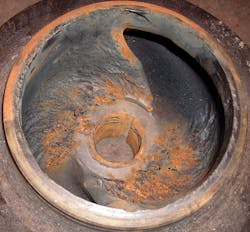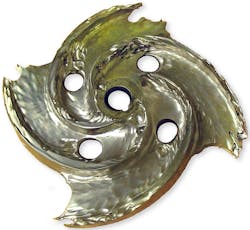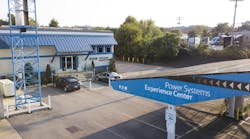Everybody likes a quiet pump — one that just does its job and doesn’t break down often. But a noisy pump raises concern. Although the noise is often attributed to cavitation, not every noisy pump is suffering from this problem. Failing bearings, flow turbulence, recirculation, and even a machine’s mechanical or electrical geometry can also generate noise — any of which may be a more immediate problem than long-term damage from cavitation.
Cavitation erodes the suction eye of the impeller without affecting its other surfaces (Photo 1). Disassembly and inspection will confirm if significant cavitation is responsible for pump noise. But before you tear that pump open, you should first rule out other potential causes with some non-intrusive tests. Here are four procedures you can follow when trying to track down the source of the noise.
Rule out bearing noise
To determine if the noise may be due to failing bearings, listen on the pump volute and bearing housing. An ultrasonic listening device is helpful, but a mechanic’s stethoscope will do. If the sound is louder on the volute than on the bearing housing, then bearing noise can be eliminated as a source.
Change suction pressure
Next, increase the suction pressure (head) if possible, and listen for a decrease in the noise. If suction head can’t be increased, reduce it, and listen for an increase in noise. Cavitation is directly related to suction head and flow, so changing either of these should cause cavitation noise to change accordingly.
Check for recirculation
If suction head changes have little effect on the noise, the source may be recirculation resulting from a discharge flow restriction, perhaps due to a blockage or closed discharge valve. For closed systems without flow rate instrumentation, verifying flow may not be easy. A portable flow meter attached to the outside of piping will provide accurate data, but such instruments can be expensive.
Another approach is to open a drain valve in the discharge line near the pump and allow flow to exit the system. If this reduces the noise at the pump, the flow through the system is very likely restricted, and recirculation is the source of the noise. Recirculation can damage pump impellers and volutes (Photo 2) and subject the pump to unnecessary vibration. Of course, it’s also a waste of the energy consumed by the pump.
Determine if the noise is related to mechanical and electrical geometry. If changes to neither the suction head nor discharge flow alter the noise characteristics of the pump, the sound is probably mechanical in nature. Mechanical sounds occur at specific frequencies related to the machine’s mechanical and electrical geometry. Vibration analysis techniques can identify and characterize these sounds and their relationship to any mechanical forces.
The most common frequency of sound and vibration on centrifugal pumps is vane-pass frequency, which occurs at multiples of the number of impeller vanes and the rotating speed. Technicians familiar with pumping machinery may well be able to audibly separate the vane pass and other mechanical sounds from the random noise of cavitation and recirculation.
Your noisy pump may be telling you something important. With a methodical approach and through the process of elimination, you can interpret its language and avoid pump failure.
Vogel is a pump and vibration specialist at the Electrical Apparatus Service Association, Inc. (EASA) in St. Louis. He can be reached at [email protected].





